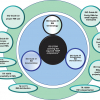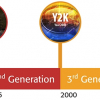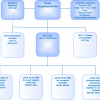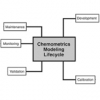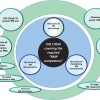John Hammond
Starna Scientific Ltd, 52–54 Fowler Road, Hainault Business Park, Hainault, Essex, IG6 3UT, UK
The Irish writer George Bernard Shaw once said: “England and America are two countries divided by a common language”. Whilst this statement generally refers to the over 4000 words in everyday use in the United States that are not in British English, in the scientific world “is it metre or meter”, or for spectroscopists, nanometre or nanometer?
However, irrespective of that debate, whatever the spelling, terms such as these have associated definitions, found in various reference texts, such as dictionaries, vocabularies or databases, and if we cannot agree on the spelling, what chance of achieving consistency in definition?
Fortunately, help is at hand, and it is the recent introduction of a “Concept Database” by ISO which has prompted this article.
Detailed below are just a few of the “databases” now available, and examination of the term “Resolution” is used as an example of each.
ISO Concept database
In November 2009, ISO launched a new database that will make the benefits of using standards easier to achieve, provide users with new possibilities for achieving such benefits and cut the time necessary to develop and revise standards. In recent years, many of the technical committees that develop ISO standards have established databases to store and administer structured concept items from published standards or ones under development, such as:
- Terms and definitions
- Graphical symbols
- Codes (language, country, currency etc.)
- Units of measurement
- Product properties
- Data dictionaries

However, until now, no platform was available to bring together in a single source the content from more than 18,000 ISO standards developed to provide benefits to users in business, government and society. To tackle this challenge, the ISO Central Secretariat in Geneva, Switzerland, has developed a new application, the ISO Concept Database (ISO/CDB), which provides a harmonised platform for search, development and maintenance of concept content throughout the ISO standards portfolio.
The ISO/CDB will allow standards users in companies and other organisations to easily access standardised reference data, with the possibility of re-using them in their own applications.
In addition, the ISO/CDB will assist ISO technical committees in developing and maintaining concept items included in standards, helping to reduce time in developing new standards and revising existing ones.
The ability to search and compare concepts from the complete portfolio of ISO standards is expected to:
- Help ISO committees in the development and maintenance of their standards
- Contribute to increasing consistency among standards
- Initially, the ISO/CDB enables search of concepts in three important categories (additional ones following on):
- Terms and definitions
- Graphical symbols
- Codes (country, currency, language and script).
The case of terms and definitions gives an example of the added value of the ISO/CDB. Through this application, standards experts will be able to access and compare all the instances of terms and definitions used by all ISO committees (either as a single word, or as a combination of words). This will enhance access to knowledge and make it easier to share. In turn, this will help to improve content quality, and prevent duplications and inconsistencies.
Most of the content of the ISO/CDB is publicly accessible via the direct URL http://cdb.iso.org or from ISO’s web site www.iso.org, by currently logging on as a Guest. An online tour of the CDB is available under http://www.iso.org/iso/demo_ISO-CDB.html
ASTM International
Available online for an annual subscription, ASTM’s new online edition of the ASTM Dictionary of Engineering Science and Technology contains nearly 80,000 terms and powerful interactive features. In addition to a clear and precise explanation of all 76,000+ technical terms contained in ASTM’s 12,000+ standards, the new online edition provides you:
- Terms and definitions not commonly found in most dictionaries
- A listing of all the ASTM standards which reference each term, as well as the ASTM committee that developed the standard
- Hot-links from each standard designation to the full scope of the standard
- Hot-links from the ASTM committees to specific information on that committee
- Powerful searching tools—by main committee, phrase, keyword, designation number or alphabetically
The definition of each term was written by technical experts in their field and reflects the sense in which that field uses the term.

However, within the “My ASTM” section of the ASTM home page (accessible to ASTM International members) is a “Terminology Dictionary” which contains 76,000 terms and features expanded search options so that searches can be done by keywords that are a part of the term or definition, or further sorted by standard or committee.
IUPAC Compendium of Chemical Terminology
The Compendium is popularly referred to as the “Gold Book”, in recognition of the contribution of the late Victor Gold, who initiated work on the first edition. It is one of the series of IUPAC “Colour Books” on chemical nomenclature, terminology, symbols and units (see the list of source documents), and collects together terminology definitions from IUPAC recommendations already published in Pure and Applied Chemistry and in the other Colour Books.

Terminology definitions published by IUPAC are drafted by international committees of experts in the appropriate chemistry sub-disciplines, and ratified by IUPAC’s Interdivisional Committee on Terminology, Nomenclature and Symbols (ICTNS). In this edition of the Compendium these IUPAC-approved definitions are supplemented with some definitions from ISO and from the International Vocabulary of Basic and General Terms in Metrology (VIM); both these sources are recognised by IUPAC as authoritative. The result is a collection of nearly 7000 terms, with authoritative definitions, spanning the whole range of chemistry.
International vocabulary of metrology—Basic and general concepts and associated terms (VIM) 3rd Edn
In general, a vocabulary is a “terminological dictionary which contains designations and definitions from one or more specific subject fields” (ISO 1087–1:2000, 3.7.2). The present Vocabulary pertains to metrology, the “science of measurement and its application”. It also covers the basic principles governing quantities and units. Also published as ISO/IEC Guide 99, it is available for download at the “VIM 3: International Vocabulary of Metrology” page of the BIPM website.
The second edition of the International vocabulary of basic and general terms in metrology (VIM) was published in 1993. The need to cover measurements in chemistry and laboratory medicine for the first time, as well as to incorporate concepts such as those that relate to metrological traceability, measurement uncertainty and nominal properties, led to this third edition. Its title is now International vocabulary of metrology—Basic and general concepts and associated terms (VIM), in order to emphasise the primary role of concepts in developing a vocabulary.
In this Vocabulary, “... it is taken for granted that there is no fundamental difference in the basic principles of measurement in physics, chemistry, laboratory medicine, biology, or engineering. Furthermore, an attempt has been made to meet conceptual needs of measurement in fields such as biochemistry, food science, forensic science, and molecular biology.”

Whilst it is commendable that this is the basis on which this vocabulary has been produced, in certain areas of expertise, there are clearly differences with the definitions detailed within the VIM, and this is only to be expected.
For example:
5.14 (6.14) certified reference material
CRM
reference material, accompanied by documentation issued by an authoritative body and providing one or more specified property values with associated uncertainties and traceabilities, using valid procedures
EXAMPLE Human serum with assigned quantity value for the concentration of cholesterol and associated measurement uncertainty stated in an accompanying certificate, used as a calibrator or measurement trueness control material.
NOTE 1 ‘Documentation’ is given in the form of a ‘certificate’ (see ISO Guide 31:2000).
NOTE 2 Procedures for the production and certification of certified reference materials are given, e.g. in ISO Guide 34 and ISO Guide 35.
NOTE 3 In this definition, “uncertainty” covers both ‘measurement uncertainty’ and ‘uncertainty associated with the value of a nominal property’, such as for identity and sequence. “Traceability” covers both ‘metrological traceability of a quantity value’ and ‘traceability of a nominal property value’.
NOTE 4 Specified quantity values of certified reference materials require metrological traceability with associated measurement uncertainty (Accred. Qual. Assur.: 2006) [45]
NOTE 5 ISO/REMCO has an analogous definition (Accred. Qual. Assur.: 2006) [45] but uses the modifiers ‘metrological’ and ‘metrologically’ to refer to both quantity and nominal property.
Ref. [45] EMONS, H., FAJGELJ, A., VAN DER VEEN, A.M.H. and WATTERS, R. New definitions on reference materials. Accred. Qual. Assur., 10, 2006, pp. 576–578
So we have both a VIM3 and ISO/REMCO definition for CRM to be used as appropriate.
So you can see, from an initial listing of 150 entries in the ISO concept database, “Resolution” can be reduced to a small number of possible definitions.
Referring to my opening remark, two small areas where at least consensus has been achieved are:
- ASTM International, (based in the USA) have a internal “Form and Style” document, affectionately known as the “Blue book”,1 which details how the structure of a standard should be composed etc. and in this document, all SI units are spelt in the –re form.
- Sulfur has traditionally been spelled sulphur in the United Kingdom (since the 14th century, most of the Commonwealth including India, Malaysia, South Africa and Hong Kong, along with the rest of the Caribbean and Ireland, but sulfur in the United States, while both spellings are used in Canada and the Philippines. IUPAC adopted the spelling “sulfur” in 1990, as did the Royal Society of Chemistry Nomenclature Committee in 1992. The Qualifications and Curriculum Authority for England and Wales recommended its use in 2000.
As previously discussed, the definition of CRM usually adopts either the ISO/REMCO or VIM definition, but here (Figure 5) is an ISO standard using a different “quality control” definition?

From a personal perspective “... you cannot please all of the people all of the time”, however, the availability of the ISO concept database will surely assist in the removal of obvious inconsistencies.


